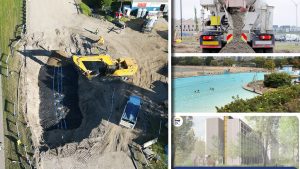Climate change seems to be on the mind of everyone these days, including the B.C. Ministry of Environment and Climate Change Strategy.
The ministry is looking for ways to improve the clean-up of contaminated sites that are vulnerable to the impact of long-term shifts in temperatures and weather patterns.
According to the Society of Contaminated Sites Approved Professionals of B.C., there are almost 8,000 contaminated sites in the province that are “unsuitable for specific uses of land, water and sediment.”
Climate change can affect these brownfield sites in several different ways, according to the ministry.
For example, wildfires can damage the remediation infrastructure that removes contaminants from groundwater.
In addition, drought can render groundwater treatment systems inoperable if they don’t have enough water to work with.
It can also reduce the dilution of groundwater, which can make the contamination that is already present more toxic.
Drought can also decrease the availability of groundwater as an alternative water source that is ready for use in case it is needed.
Climate change in the form of extreme heat increases the volatility of certain contaminants, such as gasoline. Heat can transform liquid contaminants into gas, and gas brings more people into contact with the contaminants.
Another symptom of climate change, flooding and coastal storm surges, can push contaminants onto neighbouring properties and nearby waterways as well as erode protective soil caps.
In late 2022, the environment ministry developed a discussion paper called Making Contaminated Sites Climate Ready.
The document set out some ideas for amending provincial site remediation requirements that take into account climate change and sustainability and protect the quality of groundwater.
Carrie Nugent, director of land remediation in the environment ministry, says the Making Contaminated Sites Climate Ready project is “a proactive step to prevent future significant negative effects on contaminated sites as climate changes in B.C.”
The sites in the greatest danger of being adversely affected by climate change are those that are contaminated but not yet remediated, and those that need to have long-term risk controls in place while they are being remediated.
On top of that, other sites can become contaminated following an accidental fuel or chemical spill, or the spread of contamination from other properties.
As it now stands, B.C.’s contaminated sites legislation focuses on industrial and commercial land.
In most cases, the management and monitoring of contaminated sites is the responsibility of the owner, which includes municipalities.
In some cases, the province can assume responsibility for contaminated sites that lack a viable or known owner, such as abandoned mine sites.
The ministry asked for feedback on its Making Contaminated Sites Climate Ready discussion paper and it received a total of 31 responses.
Reactions came from First Nations, several levels of government, environmental professionals, developers and industry.
The Association of Consulting Engineering Companies British Columbia (ACEC-BC) was one of the parties that responded.
“Many ACEC-BC companies have team members who are CSAPs (Contaminated Sites Approved Processionals) or have other specialties that are needed for the work,” says president and CEO Caroline Andrewes. “For example, hydrology, air quality assessment and environmental engineering.”
Five ACEC-BC members who provide contaminated site services and are themselves CSAPs wrote ACEC-BC’s response.
They offered recommendations on such issues as dealing with challenges to stakeholders undertaking contaminated site evaluation, remediation and environmental management and risk-based identification and capture of contaminated site information.
They also recommended creating a single integrated, transparent, public-facing, searchable Geographic Information System (GIS) online database that could be used as a tool to obtain all of the information – not limited to climate-readiness – that pertains to a contaminated site.
Another one of their suggestions is for the ministry to create test cases on provincial contaminated sites as guidance for the industry, before undertaking the task of writing amendments of provincial acts and regulations, and to support the synchronization of all of the changes associated with making contaminated sites climate-ready.
What is the ministry doing with all the feedback it has received?
Nugent says it is creating an Indigenous advisory group, developing a policy intentions paper and considering possible legislative changes, which are needed before any changes can be made to the contaminated sites registry.











Recent Comments
comments for this post are closed